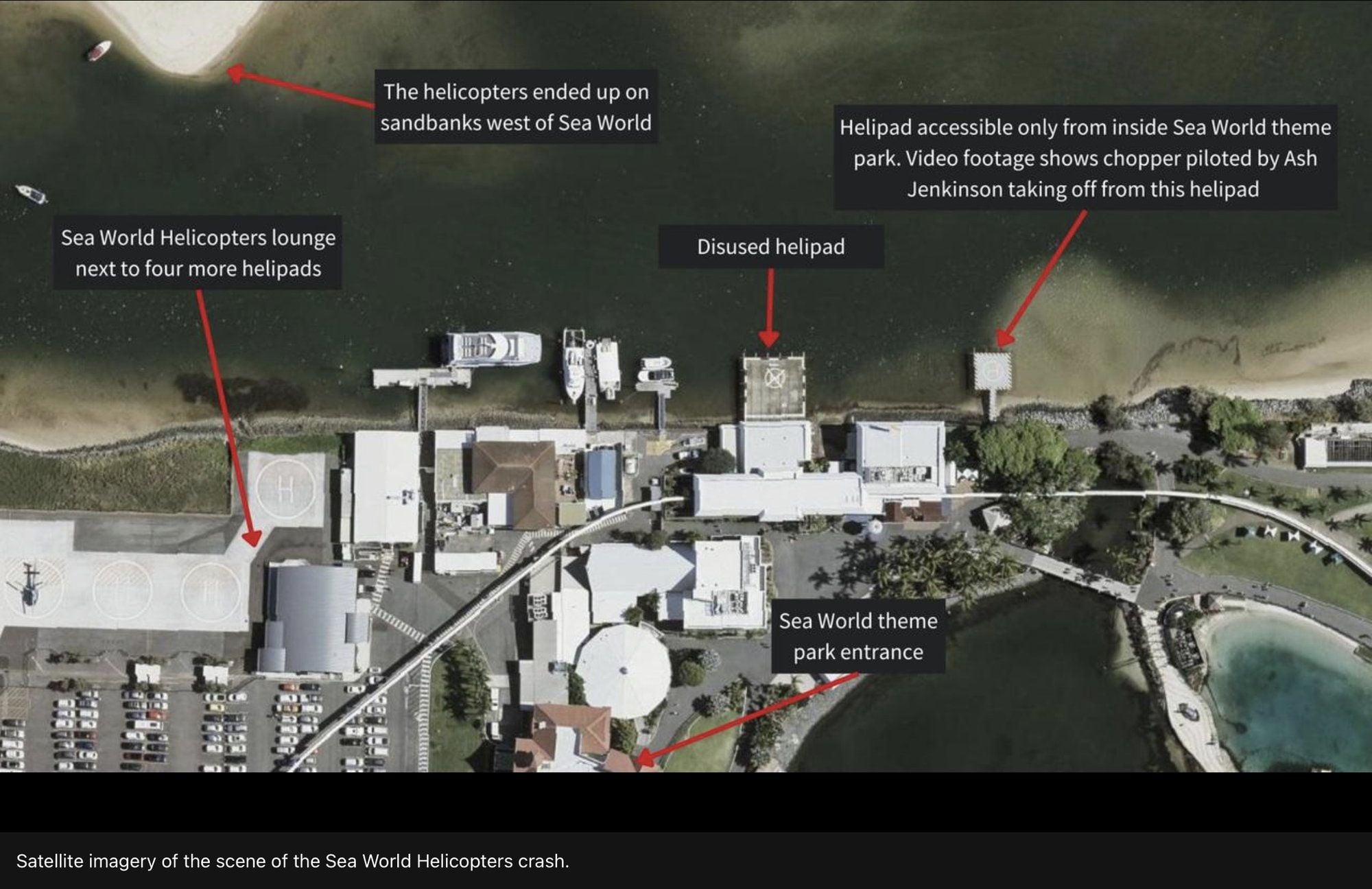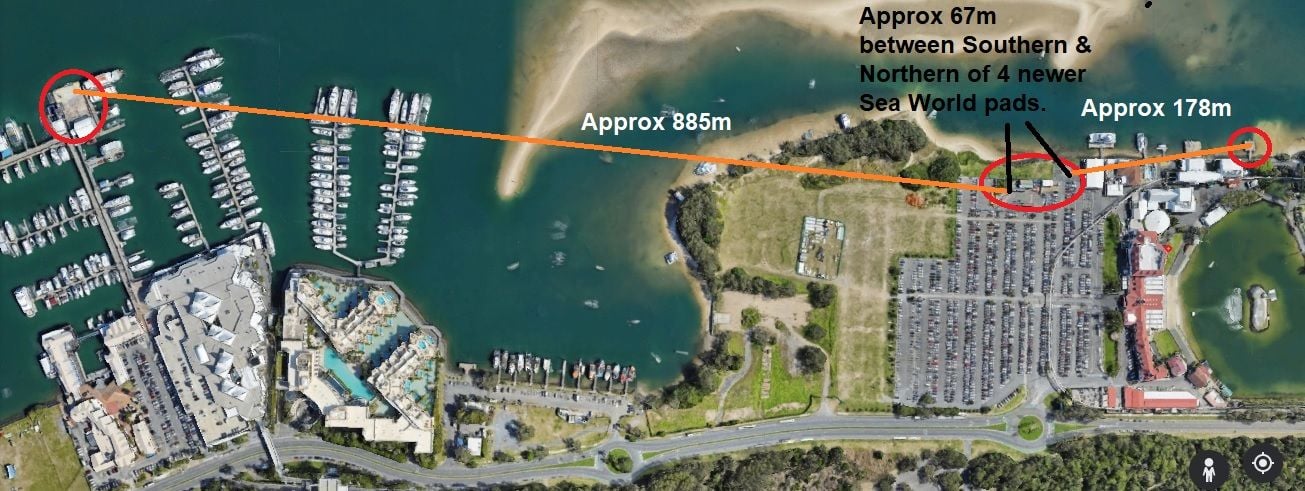Two helicopters collide - Gold Coast, Queensland - Sea World 2/1/2023
When was the decision made to operate from that helipad?
The following users liked this post:
The best thing to come out of this whole very sad situation is that first and most importantly, most involved survived. This gives investigators the opportunity to examine with the people in the incident what they saw and when and where they saw it.
About 40 years ago when it was built. They have been operating from that pad for decades - you trying to read stuff into it that isnt there is ridiculous.
two helicopters collided because one departed a helipad at 90 degrees to one landing on another helipad!
two helicopters collided because one departed a helipad at 90 degrees to one landing on another helipad!
I'm referring to the day of the accident but I think you know that
There was 180 degrees of azimuth available over water for the arriving and departing helicopters to be separated.
Yet they were in exactly the same airspace.
I wonder if that's what the local procedures called for.
If so it was a potential accident waiting to happen.
Yet they were in exactly the same airspace.
I wonder if that's what the local procedures called for.
If so it was a potential accident waiting to happen.
The takeoff would always be at 90 degrees to the land, which is full of obstacles and people. The departing machine didn't really have a choice.
While climbing out, the landing aircraft was in a blind vision spot above the roof and centre window divider, and the landing aircraft had the departing acft in his blind spot behind the A pillar. Only radio calls would have alerted them, or the efforts by the concerned pax. If he had tapped the left shoulder, a different result may have ensued, but he couldn't reach that far. And it may have been too late.
There is always a lot of cockpit distraction with joyride pax, squealing, pointing, waving cameras, and asking the pilot questions if they are on intercom. Easy to blot out a radio call.
While climbing out, the landing aircraft was in a blind vision spot above the roof and centre window divider, and the landing aircraft had the departing acft in his blind spot behind the A pillar. Only radio calls would have alerted them, or the efforts by the concerned pax. If he had tapped the left shoulder, a different result may have ensued, but he couldn't reach that far. And it may have been too late.
There is always a lot of cockpit distraction with joyride pax, squealing, pointing, waving cameras, and asking the pilot questions if they are on intercom. Easy to blot out a radio call.
The following users liked this post:
Actually your post says nothing of the sort. You think they just decided on the day hey lets operate from this pad that we have never done so from before ??. They operate from the ticket booth pad every day - its NOTHING NEW.
Better contact ATSB and tell them to stop their investigation as you seem to have worked out what caused it.
There was 180 degrees of azimuth available over water for the arriving and departing helicopters to be separated.
Yet they were in exactly the same airspace.
I wonder if that's what the local procedures called for.
If so it was a potential accident waiting to happen.
Yet they were in exactly the same airspace.
I wonder if that's what the local procedures called for.
If so it was a potential accident waiting to happen.
Last edited by Lookleft; 10th Jan 2023 at 04:19.
The takeoff would always be at 90 degrees to the land, which is full of obstacles and people. The departing machine didn't really have a choice.
What would stop a takeoff to the SW and a landing from the NW?
To be honest having seen them conduct faultless flight ops using both pads and in some cases all three pads for many years I am at a loss to understand how it all turned to custard this time. These are not amateurs and Jenko oversaw a good bunch of people. Unfortunately all the holes in the swiss cheese lined up that day.

From northern pad (used by XKQ) to nearest of the four newer Sea World pads: ~178m
Distance between centres of the extreme two of the four newer Sea World pads: ~67m
Distance between the southern most Sea World pad and northern most Gold Coast Helitours pads: ~885m
So any range of distances between pads considered to be a higher risk than others?
Following 'satellite view' is from Courier Mail extracts shared by John Eacott and shows current Sea World pad configuration:

Older Google Earth view down to the three Gold Coast Helitours pads, showing approximate distances:

On a tangent, remember the unfortunate 1985 HeliJet reef pontoon accident in which rotors of a pair of helicopters (VH-HIL, a Bell 206L and VH-HIA, a Bell 222) tangled resulting in loss of life of one passenger and serious injury for two others: https://www.atsb.gov.au/publications.../aair198503546
Without knowing the actual local procedures used by the company we can only surmise that having a departure and climbout path that has to cross an arrivals and approach path is not the greatest idea unless you have planned vertical separation as well.
Ie, arriving aircraft stays at 300' until he has positively identified departure aircraft and departing aircraft climbs to 200' until positively clear of the arrival path.
Having no crossing would be ideal but sometimes the wind conditions probably won't allow for that.
Ie, arriving aircraft stays at 300' until he has positively identified departure aircraft and departing aircraft climbs to 200' until positively clear of the arrival path.
Having no crossing would be ideal but sometimes the wind conditions probably won't allow for that.
The following users liked this post:
Crab - unfortunately for Seaworld ops there is no way to avoid crossing paths when using both sets of pads. They arent allowed to fly over the park itself so very much limits the ins and outs.
That would leave vertical and/or time separation which I'm pretty sure any competent operator would have had in place anyway along with RT calls - It will be interesting to see if the crash investigation finds why two serviceable aircraft with pilots familiar with both the area and the operation and operating to the same Ops manual managed to hit each other.
The following 3 users liked this post by [email protected]:
Cooperplace says at #306...
According to a report this morning Calls for joy flight review after deadly Gold Coast Sea World helicopter crash - ABC News
Why does it take the ATSB so long to finalise investigations? I remember the old BASI/early ATSB finished investigations in much shorter timeframes than presently happens, so what's changed to make the ATSB now need so much more time to do its job?
Interesting that the ATSB say it will take 18 months for a report
The Australian Transport Safety Bureau investigation into the cause of the tragedy is expected to take several years to conclude.
The following users liked this post:
Cooperplace says at #306...
According to a report this morning Calls for joy flight review after deadly Gold Coast Sea World helicopter crash - ABC News
Why does it take the ATSB so long to finalise investigations? I remember the old BASI/early ATSB finished investigations in much shorter timeframes than presently happens, so what's changed to make the ATSB now need so much more time to do its job?
According to a report this morning Calls for joy flight review after deadly Gold Coast Sea World helicopter crash - ABC News
Why does it take the ATSB so long to finalise investigations? I remember the old BASI/early ATSB finished investigations in much shorter timeframes than presently happens, so what's changed to make the ATSB now need so much more time to do its job?
Originally Posted by [email protected]
Without knowing the actual local procedures used by the company we can only surmise that having a departure and climbout path that has to cross an arrivals and approach path is not the greatest idea unless you have planned vertical separation as well.
Ie, arriving aircraft stays at 300' until he has positively identified departure aircraft and departing aircraft climbs to 200' until positively clear of the arrival path.
Having no crossing would be ideal but sometimes the wind conditions probably won't allow for that.
Ie, arriving aircraft stays at 300' until he has positively identified departure aircraft and departing aircraft climbs to 200' until positively clear of the arrival path.
Having no crossing would be ideal but sometimes the wind conditions probably won't allow for that.



